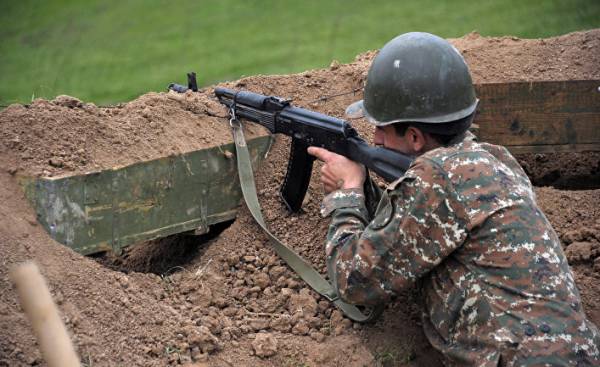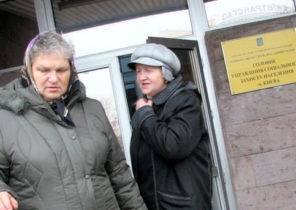
In the mountains which separate Armenia and Azerbaijan, the new European war is only a matter of time. This conflict for a hundred years. One side supported by Russia, the other to Turkey.
“Usually they shoot at night. Then we just go down to the basement and wait,” says 57-year-old Jenik Armenian border villages of Nerkin Karmirakhpyur (Nerkin Karmiraghbyur).
A few hundred metres away from the crumbling house Janik and her husband, Azerbaijani positions.
In these valleys to collect apricots, grapes and pomegranates can be deadly. Every week along the border between the two mortal enemies kill people — using guns, mortars, bombs and artillery.
“We usually go to the garden on this side of the house. Here we grow everything that we need,” says Jenik.
The most hazardous situation for 23 years
If war breaks out, it can be more dangerous than you might think. On different sides can be Russia and NATO member Turkey.
“Armenia and Azerbaijan closer to war than at any time since 1994”, stated International Crisis Group in a recent report.
Both countries modernized army with large purchases from Russia, earn billions by selling weapons to both sides.
All peace talks suspended, both sides believe that war is inevitable.
The Azerbaijani President has promised to regain control over Nagorno-Karabakh in every possible way.
The leaders of both countries have the support, causing the population to a wave of patriotism and thirst for revenge.
“Muslims for centuries have tried to destroy us”
When the team Aftenposten goes on a journey through the winding roads along the border between Armenia and Azerbaijan in the village of Berd, the neighbors give us a friendly advice — not to stop.
Although we are located 11 miles (1 Norwegian mile is 10 km. approx.ed.) from the self-proclaimed breakaway Republic of Nagorno-Karabakh, which is the core of the conflict, the war is smoldering here, among these beautiful landscapes:
Lower house is haunted with traces of bullets on both sides of the road show that the war here is on distance in some shots. Mountains — Armenian, the plain of Azerbaijan.
Exits blocked by branches: it is a warning that due to snipers and mines off the road is to put one’s life at risk.
Who shoots?
We jump from surprise, when, being on the town’s market square, hear the sound of rifle shots.
“Do not be afraid. It is our. We all, who live here, have learned to distinguish by ear” — responsible Anahit Badalyan.
She and her husband accompany us further, but insist that we are riding on their old white Lada.
“Then we will know that we are friends,” says her husband, David. He’s a lifeguard and a fireman.
Several months passed since the day when the white car of the OSCE observers was here last time. When shooting always stop.
Grandmother and grandson killed
Last week the grandmother of the Azerbaijani and grandson were killed by Armenian grenade at a border village in Azerbaijan on the border with Nagorno-Karabakh.
Armenians claim that Azerbaijan was aiming for artillery, but the Azerbaijanis accuse the breakaway Republic of provocation.
And Friday morning — while world leaders held a meeting “the twenty” — Azerbaijan led his army in the highest state of readiness and began to bomb the Armenian positions.
Turkey and Russia are on different sides
There are many signs that a new war would benefit Azerbaijan with its army with new weapons, a large number of people and resources vastly superior to those that have opponent. In recent years, the military expenditures of Baku — more than the entire state budget of Armenia.
“In the year 2100, Armenia will become empty,” wrote the Azerbaijani news Agency AzerNews last week. Both countries are waging a fierce information war.
The longer the conflict remains frozen and the more Armenians strengthening their positions, the greater the likelihood that Azerbaijan will never regain areas lost during the war, 1992-1994.
Most of the conservation conflict in the current state of Russia wins.
Russian strengthened their military base in Armenia and earn great money by selling weapons to both sides.
However, the growing Russian presence is a threat to NATO member Turkey, which describes Azerbaijan as “one nation, two States”.
FACTS: NAGORNO-KARABAKH CONFLICT
An enclave of Nagorno-Karabakh was given to Azerbaijan by Stalin in 1923. In 1989, a large part of the population in the area (76.4 per cent) were Armenians.
— After the Soviet collapse, ethnic tensions escalated. In 1991, Azerbaijan declared independence and abolished the autonomy of the enclave. Armenians living in Nagorno-Karabakh demanded unification with Armenia.
— The war 1992-1994 20-35 claimed thousands of lives and made one million people refugees.
Today Nagorno-Karabakh, economically and militarily controlled by Armenia, but from the point of view of the international community is considered part of Azerbaijan.
Azerbaijan district, because of which the conflict occurred, equal to 20% of the country, and for Armenia — one-third.
Therefore, the conflict is so dangerous
Therefore, a new war between Azerbaijan and Armenia can quickly be drawn into the conflict both Russia and Turkey-a NATO member.
Russia had earlier made it clear that if the Armenians would lose, she would go to military intervention.
Turkey for its part would never allow that Armenians moved forward and occupied new territory. It talks you need to have on hand the best cards.
Both sides have missiles of distant radius of action, which may affect the civilian population of big cities.
A young woman defies fear
“War destroys everything. The last war is still killing,” says Anahit Badalyan, a woman who decided to go against the flow.
Although after the collapse of the USSR Byrd had lost half of the population, Anahit, after studying at the Yerevan University, chose to return home.
Together with the Homeland Development Initiative Foundation and honorary Consul of Norway and Finland Timothy Straight (Straight Timothy) anahid has created a resource center for women Byrd and provided about 40 women work. They are going each day to crochet figurines are little bears, trinkets and Souvenirs.
Straight came to Armenia for the humanitarian organization 18 years ago, but chose to stay when his organization went on to help in other conflicts.
“You only have to recognize that this conflict the world has forgotten,” says Straight.
The four day war
In April last year, daily clashes have led to a “four day war”, which made it clear how little you need to it all started again.
Azerbaijan took two important heights after both sides lost several hundred soldiers. Baku was drunk with victory, 65% of the population wanted to continue the war.
The popularity of the Aliyev family, ruling in Azerbaijan has increased, criticism of corruption and human rights violations subsided.
In Armenia and the breakaway Republic of Nagorno-Karabakh started ambitious domestic proceedings that led to large-scale military reform and to a powerful desire for revenge.
The Armenian Diaspora is also contributing — it was sent to the breakaway Republic $ 11 billion.
The war forced both Armenians and Azerbaijanis to believe in the possibility of a “final solution” with weapons, said the International Crisis Group.
Most women suffer
“Many Armenians are convinced that the ultimate goal of Turkey and Azerbaijan to destroy us. Muslims attack us for centuries. So we are afraid that they want to destroy us,” says Anahit.
The Armenians still remember the genocide of Armenians in Turkey between 1915 and 1923 that killed between one and a half million Armenians.
The current leadership of Turkey punishes the use of the word “genocide” and argues that it was only about the “deportations” in war.
“We have every reason to fear destruction. But I am one of those who believes that the conflict cannot be resolved with weapons,” says Anahit.







